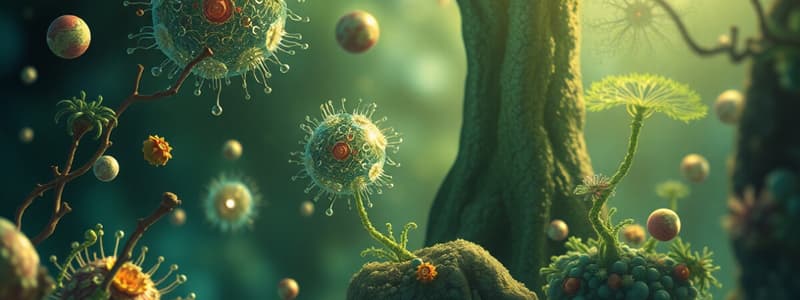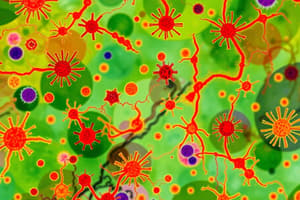Podcast
Questions and Answers
What formatting should be used for genus and species names in written form?
What formatting should be used for genus and species names in written form?
- Both names should be printed in bold.
- Only the species name is italicized.
- Both names should be italicized and underlined if handwritten. (correct)
- The genus is italicized, and the species is underlined.
Which of the following statements regarding microorganisms and their environments is true?
Which of the following statements regarding microorganisms and their environments is true?
- Microorganisms are only found in specific biological environments.
- All microorganisms are harmful and cause diseases.
- Soil microbes contribute to nutrient cycling by breaking down organic matter. (correct)
- Microorganisms play no significant role in any ecosystem.
What is a primary role of microorganisms that contain chloroplasts?
What is a primary role of microorganisms that contain chloroplasts?
- They exclusively invade other organisms to cause disease.
- They break down carbon compounds for nitrogen fixation.
- They carry out photosynthesis, processing carbon dioxide into energy. (correct)
- They produce energy solely for mammalian consumption.
Which statement correctly describes the relationship between microbes and the human digestive system?
Which statement correctly describes the relationship between microbes and the human digestive system?
What is one common function shared among various microorganisms?
What is one common function shared among various microorganisms?
What type of microorganisms may contain both prokaryotic and eukaryotic cells?
What type of microorganisms may contain both prokaryotic and eukaryotic cells?
Which characteristic is NOT a morphological characteristic of microorganisms?
Which characteristic is NOT a morphological characteristic of microorganisms?
Which microorganism requires a living host cell for growth?
Which microorganism requires a living host cell for growth?
What is the basic distinction among viruses based on?
What is the basic distinction among viruses based on?
What type of culture is needed to study microorganisms effectively?
What type of culture is needed to study microorganisms effectively?
In which temperature range do most human pathogenic bacteria thrive?
In which temperature range do most human pathogenic bacteria thrive?
Which of the following microorganisms utilize light as a source of energy for growth?
Which of the following microorganisms utilize light as a source of energy for growth?
Which of these is a chemical characteristic of microorganisms?
Which of these is a chemical characteristic of microorganisms?
Which statement best describes how microorganisms can differ in their metabolic characteristics?
Which statement best describes how microorganisms can differ in their metabolic characteristics?
What role do antibodies play in the identification of microorganisms?
What role do antibodies play in the identification of microorganisms?
Which aspect of DNA in microorganisms aids in their characterization?
Which aspect of DNA in microorganisms aids in their characterization?
What is the main characteristic that defines a microorganism as pathogenic?
What is the main characteristic that defines a microorganism as pathogenic?
Which of the following statements is true regarding the ecological characteristics of microorganisms?
Which of the following statements is true regarding the ecological characteristics of microorganisms?
In binomial nomenclature, when is capitalization used correctly?
In binomial nomenclature, when is capitalization used correctly?
Which statement about genetic characteristics in microorganisms is false?
Which statement about genetic characteristics in microorganisms is false?
Which phenomenon demonstrates the concept of specificity in antibodies and antigens?
Which phenomenon demonstrates the concept of specificity in antibodies and antigens?
Flashcards
Microorganism
Microorganism
A tiny organism, often single-celled, that can only be seen with a microscope. They are the smallest life forms on Earth.
Prokaryotic Cell
Prokaryotic Cell
A cell that lacks a nucleus and other membrane-bound organelles, like bacteria and archaea.
Eukaryotic Cell
Eukaryotic Cell
A cell with a nucleus and other membrane-bound organelles, like algae, fungi, protozoa, and animals.
Microbial Morphology
Microbial Morphology
Signup and view all the flashcards
Microbial Cultural Characteristics
Microbial Cultural Characteristics
Signup and view all the flashcards
Culture Medium
Culture Medium
Signup and view all the flashcards
Incubation Temperature
Incubation Temperature
Signup and view all the flashcards
Oxygen Requirement
Oxygen Requirement
Signup and view all the flashcards
Why is Bacillus anthracis italicized?
Why is Bacillus anthracis italicized?
Signup and view all the flashcards
What is a Strain?
What is a Strain?
Signup and view all the flashcards
Where are microorganisms found?
Where are microorganisms found?
Signup and view all the flashcards
How do microbes reproduce?
How do microbes reproduce?
Signup and view all the flashcards
What makes some microbes harmful?
What makes some microbes harmful?
Signup and view all the flashcards
Metabolic Differences
Metabolic Differences
Signup and view all the flashcards
Antigenic Markers
Antigenic Markers
Signup and view all the flashcards
DNA Base Composition
DNA Base Composition
Signup and view all the flashcards
Plasmid DNA
Plasmid DNA
Signup and view all the flashcards
Pathogenicity
Pathogenicity
Signup and view all the flashcards
Ecological Niche
Ecological Niche
Signup and view all the flashcards
Binomial Nomenclature
Binomial Nomenclature
Signup and view all the flashcards
Species Name Usage
Species Name Usage
Signup and view all the flashcards
Study Notes
General Characteristics of Microorganisms
- Microorganisms are the smallest organisms on Earth, also known as microscopic organisms.
- They can be composed of prokaryotic or eukaryotic cells and are either single-celled or multicellular.
- Examples include algae, fungi, protozoa, bacteria, and viruses.
- Microorganisms play important roles in ecosystems, performing various functions like photosynthesis, waste breakdown, and infecting other organisms.
Major Characteristics of Microorganisms - Morphology
- Morphology involves cell shape, size, and structure, along with special structures, developmental forms, staining reactions, motility, and flagellar arrangement.
- Pure cultures are necessary for studying microorganisms.
- Different types of microscopy (like electron microscopy) are used to characterize microorganisms and examine detailed cell structures.
Major Characteristics of Microorganisms - Chemistry
- Microbial cells are made up of various organic compounds.
- Microorganisms have unique chemical compositions, exhibiting both quantitative and qualitative differences.
- Gram-negative bacteria contain lipopolysaccharide in their cell walls.
- Viruses are distinguished based on their nucleic acid type (DNA or RNA).
Major Characteristics of Microorganisms - Culture
- Growth depends on nutritional requirements and physical conditions.
- Culture mediums include inorganic and organic compounds (like amino acids, sugar, vitamins). Complex substances (like peptone and blood cells) can also be needed.
- Some microorganisms require living host cells for growth (e.g., rickettsias).
- Incubation temperature is important; some bacteria thrive at temperatures above 40°C, while others prefer temperatures below 20°C. Pathogenic bacteria typically grow at body temperature (37°C).
- Oxygen and light levels also influence growth.
Major Characteristics of Microorganisms - Metabolism
- The metabolic processes of various microorganisms provide ways to characterize and differentiate them.
- Some bacteria use light as an energy source, while others oxidize inorganic or organic compounds.
- Microorganisms vary in their methods of synthesizing cell components during growth. Different microorganisms produce distinct enzymes.
Major Characteristics of Microorganisms - Antigenic
- Microbial cells have specific antigens.
- Specific antibodies bind to these antigens.
- Antibodies can be used to identify microorganisms (lock-and-key mechanism). Example: Typhoid bacterium.
Major Characteristics of Microorganisms - Genetics
- Microorganism DNA has constant and specific features, including DNA base composition and nucleotide base sequences, that aid in their characterization.
- Plasmid DNA, alongside chromosomal DNA, contributes special characteristics, such as toxin production, antibiotic resistance, and unusual nutrient usage.
Major Characteristics of Microorganisms - Pathogenicity
- Microorganisms can cause disease in animals, plants, and other microorganisms (e.g., bacteriophages).
- Bacteriophages infect and destroy bacteria.
Major Characteristics of Microorganisms - Ecology
- Habitat is a key characteristic.
- Marine microorganisms differ from those in fresh water.
- Microorganisms in the oral cavity and intestinal tract vary.
Binomial Nomenclature
- Microorganisms are named using a two-part system (genus and species).
- The genus name is always capitalized, and the species name is not.
- Both genus and species names are written in italics.
Microorganisms and the Environment
- Microbes are ubiquitous.
- Bacteria are present on skin and eyelashes.
- Digestive health depends on beneficial microbes.
- Microorganisms with chloroplasts perform photosynthesis, like algae.
- Soil microbes decompose organic matter into nutrients.
- Some microbes cause disease.
- The primary goal of all microbes is reproduction.
Studying That Suits You
Use AI to generate personalized quizzes and flashcards to suit your learning preferences.



